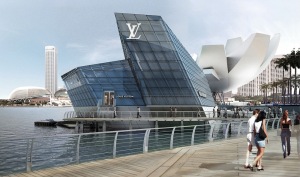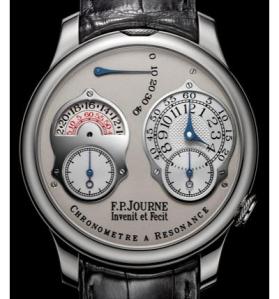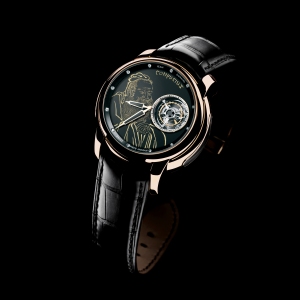FT: Flagship armada
By Lucie Greene
This month Louis Vuitton unveiled its latest flagship store, in Singapore’s Marina Bay Sands. Floating 50 metres off shore, the “Island”, designed by Peter Marino, can be entered via a 33-metre underwater tunnel lined with fine art and has its own jetty. There is a terrace in the style of a yacht’s deck, sweeping floor-to-ceiling windows with ocean views, and a dramatic hub with an 11-metre-high pointed ceiling. Sailing ships’ masts hang in the air.
“We’re seeing a huge investment in retail environments,” says Chris Sanderson, co-founder of The Future Laboratory. “Brands are reappraising what the flagship means and its value. They’re using words like ‘home’ and ‘world’. The whole perspective has changed. They’re understanding that customers rely on the retail experience to develop and continue their relationship with the brand both on- and offline.”
Yves Carcelle, chief executive of Louis Vuitton, agrees. “We offer our customers a unique experience, whether they are in Tokyo, New York, Paris, Singapore or Milan. Customers coming though the doors of our stores are looking for much more than the product they need or they would like,” he says.
http://www.ft.com/cms/s/0/e61faf54-e92f-11e0-af7b-00144feab49a.html#ixzz1ZPJfHfyL
WSJ: The Ultimate Power Moves
The craft of independent watchmakers yields incomparable luxury and unique aesthetics.
By Michael Clerizo
There are a handful of independent watchmakers, artisans really, who create the ultimate luxury timepieces in their own ateliers. Where even the high-end brands rely in great part on computer machinery and technicians, most independents finish their pieces by hand. Ferocious guardians of their distinct styles, they imbue their watches with a sense of personality that big brands can’t rival. These watches take time to build, often up to year, and thus the price is near that of a luxury car, which is little obstacle for true watch fanatics, many of whom have assembled small collections, reveling in their unique nature. Here are three favorites, chosen by our watch expert.
http://online.wsj.com/article/SB10001424053111904836104576557072671411518.html?mod=googlenews_wsj
FT: Specifications for the way we live now
By Rachel Sanderson
As the fashion pack leaves Milan for the start of the Paris shows on Tuesday, one designer will go with them: Alessandra Facchinetti, late of Valentino and Gucci, who is making her return to fashion after three years via the launch of a brand far removed from her couture and high fashion roots.
Ms Facchinetti, 39, has teamed up with Pinko, an Italian fast fashion/low luxury brand, to create Uniqueness, a brand predicated on the idea of affordable clothes that can be worn at any time, in any season, and that will be available online as they appear on the catwalk.
http://www.ft.com/cms/s/2/de4d8420-e828-11e0-9fc7-00144feab49a.html#ixzz1ZMNynSVS
Europa Star: The trend for exclusivity
Not content with limited editions or unique pieces, an increasing number of watch collectors are now commissioning their very own timepieces, but is this trend a boon or bane for the watch industry?
By Sophie Furley
It doesn’t matter what a collector collects: watches, cars, paintings, first editions or marbles – the most favoured objects will always be those that are the rarest and most exclusive. In a world that appears to be growing forever smaller, there is a certain gratification in knowing that only one, or seven, or even 99 people in the whole world are walking around wearing the exact same watch.
http://www.europastar.com/magazine/features/1004084014-tailored-time.html
Europastar: Japanese art meets Swiss mechanics
Japanese maki-e lacquer brings a touch of the East to Swiss watchmaking with techniques that are even older than the measurement of time.
By Sophie Furley
Japanese lacquer dates back to Japan’s Jomon period, 5,000 BC, and like many of the Swiss watch arts (enamel, guilloché and engraving), it came very close to extinction. Today only a handful of dedicated craftsmen are keeping this ancient tradition alive, with a little help from the Swiss watch industry.
Brands such as Vacheron Constantin, Van Cleef & Arpels, Chopard, Peter-Speake-Marin, Jean Dunand and Angular Momentum have become captivated by this magical Asian art and are working together with lacquer artists to create dials that are miniature works of art.
http://www.europastar.com/magazine/features/1004084015-japanese-art-meets-swiss-mechanics.html
Esquire: Tourbillons: Worth It, Unless You’d Like a New House
By Jeremy Kirkland
Every night, I used to set my watch on its side to keep it from gaining or losing too much time while I caught up on sleep. Mechanical watches: They’re lovely. But they’re also subject to this thing called gravity. If only I had a tourbillon…
Back in 1795, there was a man named Abraham-Louis Breguet — you may recognize his last name if you’re a watch collector — who noticed his pocket watches weren’t keeping accurate time. Turns out, it was because of the way they were hanging down from his waist coat. Gravity’s pull would offset the balance wheel, the piece which actually kept the time and rotated the cogs in place. Soon (and get ready for some mechanic speak), he realized that, by isolating the escapement and balance wheel in a rotating cage, he could counter the effect of gravity that was knocking his watch off time.
http://www.esquire.com/blogs/mens-fashion/what-a-tourbillon-092811#ixzz1ZPHExGfj



